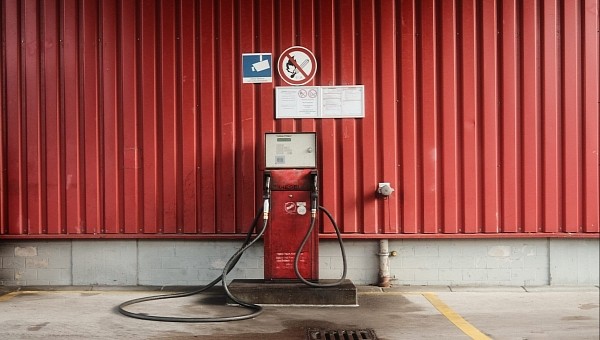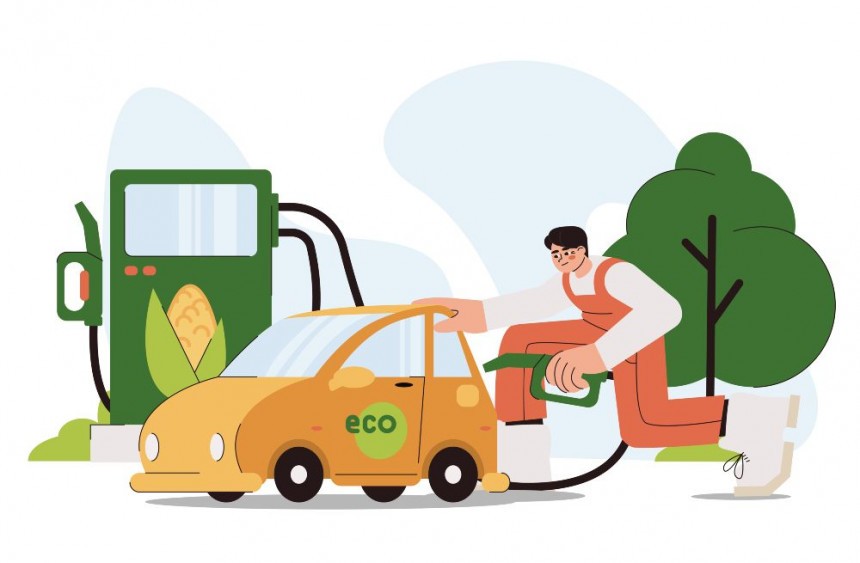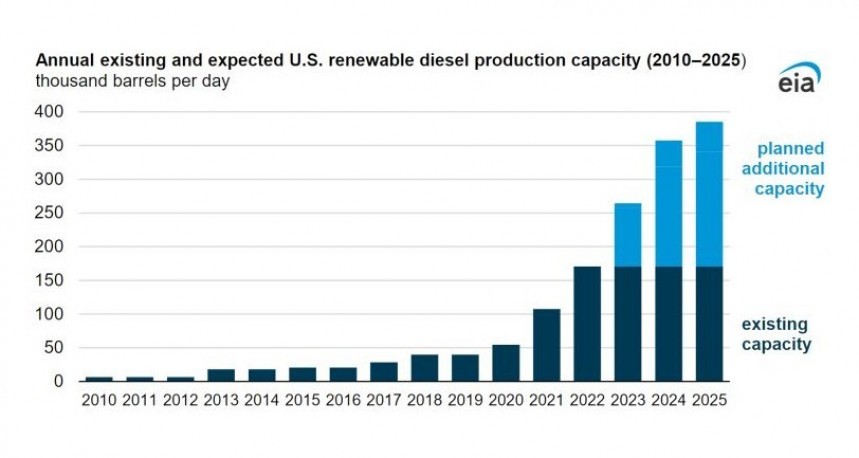A recent EIA study – EIA is the U.S. Energy Information Administration, so this is solid information – forecasts that renewable diesel production in the U.S. could more than double through 2025. So, is it good news, or should we worry about climate goals?
First of all, forget about the European “Dieselgate,” as less than 5% of passenger cars and SUVs, or light trucks in the U.S. have diesel engines. Most Americans use gasoline-powered cars. Instead, diesel fuel is used by trucks, trains, boats, generators, construction and farming vehicles, and other heavy equipment.
The U.S. transport and industry sectors are using roughly 150 million gallons per day of diesel fuel, which is about 15% of total U.S. petroleum consumption. The drawback is the related pollution and emissions of large and powerful diesel engines are very difficult to control.
The main issues are related to NOx and fine particulate emissions, PM10 and PM2.5. The latter is the subject of a new proposal from the EPA to strengthen the annual PM2.5 standards from its current level of 12.0 µg/m3 to as low as 9.0 µg/m3. This is an important 25% reduction in fine particulate emissions, and it means trouble for the companies in the diesel engines business.
Since the early 2000s, U.S. biodiesel consumption increased substantially, and in 2020, it was second to fuel ethanol as the most produced and consumed biofuel in the United States. It is used in blends with petroleum diesel in ratios of 2 to 20% and slightly reduces emissions while prolonging engines’ lifetime thanks to its lubrication qualities.
Renewable diesel is more recent, as it started to be produced in significant quantities only from 2013 onward. It is sort of a biodiesel because it’s made from agricultural waste, like vegetable oils and animal fats. But it is not your regular biodiesel because of the process used to make it.
The biggest difference is renewable diesel is made by hydrotreating, while regular biodiesel is made by transesterification. The latter process consists of introducing oxygen into the fuel, and this is where renewable diesel has a serious edge over biodiesel, and fossil diesel as well.
Because of the oxygen, biodiesel has some drawbacks:
On the other hand, renewable diesel is chemically the same as petroleum diesel, so it may be used as a drop-in fuel or it can be blended with petroleum diesel or biodiesel.
So it really seems like a “too good to be true” fuel. Well, there is an important dark side of renewable diesel – it’s pricey. It costs about $1 more per gallon than regular diesel, which makes it more than $6/gallon. Simply put, it’s the most expensive fuel for diesel engines.
And now, the Inflation Reduction Act extended the biomass-based diesel federal tax credits through 2024. So renewable diesel is suddenly more attractive to more companies in other states. Government incentives have that effect, you know.
Basically, you can turn a diesel truck fleet into a less polluting one overnight. Because they simply must switch to renewable diesel, without worries. And it can be stored and transported using the regular diesel infrastructure. It also requires minor changes for refineries to adapt to producing the new fuel.
Data from 2021 shows the demand is simply too high. The 2021 U.S. production was 0.82 billion gallons, and consumption was 1.16 billion gallons. The rest of the nearly 0.34 million gallons were imported from Asia. At the end of 2022, EIA estimates the U.S. renewable diesel production capacity was about 170,000 barrels per day, in six operating facilities.
In 2022 and early 2023, eight new renewable diesel refineries began production, and there are more other projects that are either under construction or could start development soon. If they are not delayed or canceled, EIA forecasts a total production of more than 380,000 barrels per day or 5.9 billion gallons per year by the end of 2025.
Turning to other eligible feedstock sources, like palm oil, is only contributing to further deforestation and destruction of natural habitats. This is a reminder of the fierce debate about biodiesel’s influence on world hunger: if we turn the crops into fuel, what are we going to eat?
In the meantime, the same EIA forecasts crude oil production in the U.S. will increase to new records in 2023 and 2024, while global petroleum consumption will peak in 2024 due to lower crude oil prices. This is a factor that can put a lot of pressure on the Total Cost of Ownership for fleets, and cheaper diesel could offset renewable diesel’s advantages in terms of slashing emissions.
And let’s not forget that heavy-duty diesel engines will not be sold after 2040 in the United States, even if they use renewable diesel. So, all that investments are only for the short- and medium-term, and they must pay off rather quickly.
Don’t pop that champagne just yet. Renewable diesel is not here to stay. Yes, it seems like a very handy solution to lower diesel emissions and is much more cost-effective for the moment than new technologies like batteries or hydrogen. But by the end of this decade, there’s a big chance for it to become obsolete. Like diesel engines.
The U.S. transport and industry sectors are using roughly 150 million gallons per day of diesel fuel, which is about 15% of total U.S. petroleum consumption. The drawback is the related pollution and emissions of large and powerful diesel engines are very difficult to control.
The main issues are related to NOx and fine particulate emissions, PM10 and PM2.5. The latter is the subject of a new proposal from the EPA to strengthen the annual PM2.5 standards from its current level of 12.0 µg/m3 to as low as 9.0 µg/m3. This is an important 25% reduction in fine particulate emissions, and it means trouble for the companies in the diesel engines business.
Is there a cleaner diesel fuel?
Lucky for them, less polluting diesel fuels have been around for some years. And they seem to be the best solution in the short term for all those diesel-powered fleets. I’m talking about biodiesel and renewable diesel. What’s the difference? Because, oddly, they are not the same, though they are both made of nonpetroleum resources.Renewable diesel is more recent, as it started to be produced in significant quantities only from 2013 onward. It is sort of a biodiesel because it’s made from agricultural waste, like vegetable oils and animal fats. But it is not your regular biodiesel because of the process used to make it.
The biggest difference is renewable diesel is made by hydrotreating, while regular biodiesel is made by transesterification. The latter process consists of introducing oxygen into the fuel, and this is where renewable diesel has a serious edge over biodiesel, and fossil diesel as well.
Because of the oxygen, biodiesel has some drawbacks:
- it’s not reliable as a fuel by itself, so it must be mixed with other fuels
- it causes issues with freezing temperatures, so it’s not suitable for colder environments
- it is a solvent that degrades rubber fuel lines, and also can cause problems with fuel tanks, engine fuel systems, and filters
- it can cause higher emissions if engines are not properly tuned for the diesel-biodiesel mixture
On the other hand, renewable diesel is chemically the same as petroleum diesel, so it may be used as a drop-in fuel or it can be blended with petroleum diesel or biodiesel.
- because it is hydrogenated, meaning it doesn’t contain oxygen, it’s free of the freezing challenges of biodiesel
- it burns cleaner than biodiesel and is almost on par with regular diesel regarding engine performance
- it can yield up to 80% lower lifecycle emissions than fossil-based diesel
- its carbon intensity is also 50-80% lower than conventional diesel
So it really seems like a “too good to be true” fuel. Well, there is an important dark side of renewable diesel – it’s pricey. It costs about $1 more per gallon than regular diesel, which makes it more than $6/gallon. Simply put, it’s the most expensive fuel for diesel engines.
So how come renewable diesel is on the rise?
Maybe you are aware that California is way ahead of other states in terms of environmental and lowering emissions goals. Its Low-Carbon Fuel Standard paved the way for renewable diesel a decade ago, that’s why nearly all domestically produced and imported renewable diesel is used in California.And now, the Inflation Reduction Act extended the biomass-based diesel federal tax credits through 2024. So renewable diesel is suddenly more attractive to more companies in other states. Government incentives have that effect, you know.
Basically, you can turn a diesel truck fleet into a less polluting one overnight. Because they simply must switch to renewable diesel, without worries. And it can be stored and transported using the regular diesel infrastructure. It also requires minor changes for refineries to adapt to producing the new fuel.
In 2022 and early 2023, eight new renewable diesel refineries began production, and there are more other projects that are either under construction or could start development soon. If they are not delayed or canceled, EIA forecasts a total production of more than 380,000 barrels per day or 5.9 billion gallons per year by the end of 2025.
Expect high prices on feedstock. And maybe environmental issues
Doubling production capacity for renewable diesel has some serious effects on the supply chain. Experts are concerned about rising food prices, as the most affordable until now were soybean and canola. For instance, soybean oil demand is expected to outstrip U.S. production, and imports could drive the prices even higher than expected.Turning to other eligible feedstock sources, like palm oil, is only contributing to further deforestation and destruction of natural habitats. This is a reminder of the fierce debate about biodiesel’s influence on world hunger: if we turn the crops into fuel, what are we going to eat?
In the meantime, the same EIA forecasts crude oil production in the U.S. will increase to new records in 2023 and 2024, while global petroleum consumption will peak in 2024 due to lower crude oil prices. This is a factor that can put a lot of pressure on the Total Cost of Ownership for fleets, and cheaper diesel could offset renewable diesel’s advantages in terms of slashing emissions.
Don’t pop that champagne just yet. Renewable diesel is not here to stay. Yes, it seems like a very handy solution to lower diesel emissions and is much more cost-effective for the moment than new technologies like batteries or hydrogen. But by the end of this decade, there’s a big chance for it to become obsolete. Like diesel engines.









